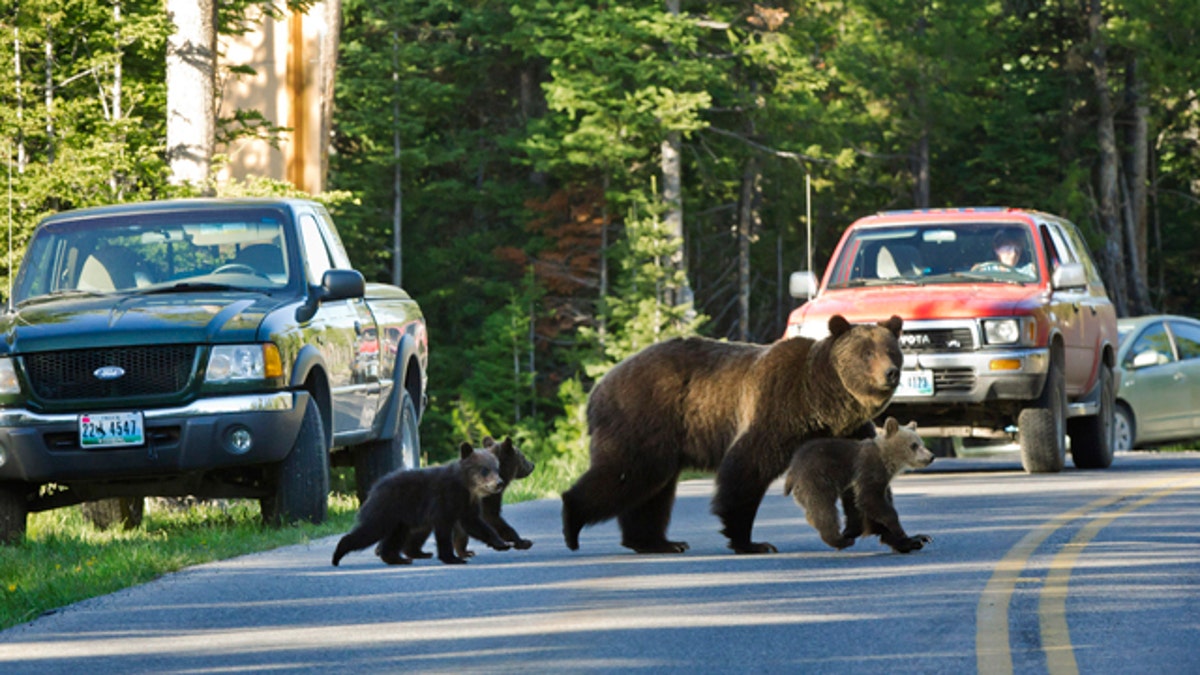
FILE - This June 2011 file photo shows Grizzly bear No. 399 crossing a road in Grand Teton National Park, Wyo., with her three cubs. Grand Teton National Park is tightening its rules against getting too close to wildlife after two incidents in which a bear charged people as they stood on their cars. The new rules say when a ranger tells people to back away from wildlife, they must listen. (AP photo/Tom Mangelsen, File) (AP)
As the saying goes, the road to hell is paved with good intentions — even when it runs through cornfields.
In 2007, with the best of intentions, Congress passed the Renewable Fuel Standard (RFS) to reduce dependence on foreign oil, accelerate development of sustainable biofuels, and reduce greenhouse gas emissions.
Nine years later, we are living with the severe unintended consequences: large-scale loss of wildlife habitat (especially native grasslands) and degradation of water quality.
Simply put, the RFS has been devastating for wildlife. This is a government-created crisis and it’s time for reform.
According to a recent University of Wisconsin study, we’ve lost more than 7.3 million acres of wildlife habitat due to agricultural expansion since 2008 — the majority of it due to expanded corn production, and two-thirds of it on lands deemed marginal or unsuited for cultivation. The reason: higher corn prices, driven by the RFS.
Since 2008, we’ve lost more than 5.7 million acres of grasslands that supports ducks, pheasants, grouse, and songbirds, like meadowlarks and longspurs, as well as imperiled pollinators, like native bees and monarchs.
In five states — North Dakota, South Dakota, Nebraska, Minnesota and Iowa — we’ve lost nearly 1.3 million acres of grasslands, a rate of habitat loss equal to the deforestation rates of Brazil and Malaysia, according to a study from South Dakota State University.
We have also been rapidly losing wetlands in the western Prairie Pothole Region — America’s Duck Factory, where more than 60 percent of waterfowl rear their young.
Behind it all is the legislated mandate to produce renewable, corn-based ethanol, even though some studies show that it produces more carbon emissions than the petro-fuels it is supposed to replace. Before the RFS, only 9 percent of all corn was produced for ethanol. Today, it’s more than 40 percent.
Expanded and intensified corn production also results in more nutrient pollution in our waterways, contributing to larger and more prevalent toxic algal blooms. The reason is that corn requires high levels of fertilizers, which can run off into waterways during heavy rains.
When we lose grasslands, wetlands, and forest buffers, we also lose the natural filtration capacity that kept sediment, nutrients, and other pollutants out of streams, rivers, and lakes. And when we plant crops on marginal lands that require significant irrigation, we often deplete scarce water supplies in drought-prone areas.
This is especially bad news for anglers, but, as residents of Toledo, Ohio, experienced when a toxic algal bloom poisoned their drinking water supply for three days in 2014, it can threaten public health and paralyze local economies.
The worst part is that none of this was supposed to happen. In the law, Congress defined acceptable biofuels under the mandate as those coming from crops grown on land that was in agricultural production before 2007.
The Environmental Protection Agency has completely failed to implement this requirement.
Furthermore, the law clearly states that EPA should reduce the mandated volumes if they “would severely harm the economy or environment.” EPA has repeatedly failed to even acknowledge the massive habitat loss and water degradation. The triennial report that is supposed to assess the environmental harms is several years overdue.
Now that we know the damage, what should we do about it?
First, EPA needs to follow the law: produce the required environmental report, prevent additional habitat loss, and reduce mandated ethanol volumes due to the land and water impacts.
Second, Congress should make the RFS more wildlife-friendly: strengthen provisions that prevent the conversion of non-agricultural lands, and require more frequent assessments of impacts, and reduce requirements below the 10 percent level of ethanol that is blended into most motor fuels
Finally, Congress should restore funding for effective habitat conservation programs, like the Conservation Reserve Program, as well as revisit other policies that distort markets at the expense of wildlife and water. Coupling these investments with reforms will help keep farming profitable.
The RFS is a well-intentioned law that has utterly failed the first rule of policymaking: do no harm.
By responsibly enforcing current laws and making wildlife-friendly reforms, our great nation will enjoy both healthy wildlife populations and a thriving agricultural sector for generations to come.
